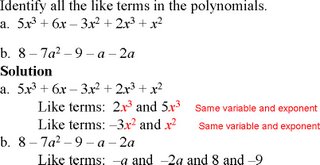Polynomials: Operations 4.3
4.3 INTRODUCTION TO POLYNOMIALS
a. Evaluate a polynomial for a given value of a variable.
b. Identify the terms of a polynomial.
c. Identify the like terms of a polynomial.
d. Identify the coefficients of a polynomial.
e. Collect the like terms of a polynomial.
f. Arrange a polynomial in descending order, or collect like terms and then arrange in descending order.
g. Identify the degree of each term of a polynomial and the degree of the polynomial.
h. Identify the missing terms of a polynomial.
i. Classify a polynomial as a monomial, binomial, trinomial, or none of these.


Objective a
Evaluate a polynomial for a given value of a variable.
When we replace the variable in a polynomial with a number, the polynomial then represents a number called a value of the polynomial. Finding that number, or value, is called evaluating the polynomial.
Example A

Example B

Example C

Objective b
Identify the terms of a polynomial.
Example D

Objective c
Identify the like terms of a polynomial.
When terms have the same variable and the variable is raised to the same power, we say that they are like terms.
Example E

Objective d
Identify the coefficients of a polynomial.

Objective e
Collect the like terms of a polynomial.
Example G Combine like terms.

Objective f
Arrange a polynomial in descending order, or collect like terms and then arrange in descending order.
Example H

Objective g
Identify the degree of each term of a polynomial and the degree of the polynomial.


Objective h
Identify the missing terms of a polynomial.

Example L

Objective i
Classify a polynomial as a monomial, binomial, trinomial, or none of these.


0 Comments:
Post a Comment
Subscribe to Post Comments [Atom]
<< Home